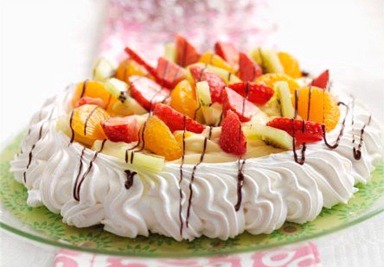
stock photo
Pavlova is a soft centered meringue cake decorated with whipped cream and fruit. The question of which country, Australia or New Zealand, first came up with the idea of the pavlova may never be answered. Both lay claim to the invention of this sweet dessert, but neither one can prove it.
It has been thought that in 1935, the chef of the Hotel Esplanade in Perth, Western Australia, Herbert Sachse, created the pavlova to celebrate the visit of the great Russian ballerina, Anna Pavlova.
It has also been thought that the dessert gently evolved from years of recipe-swapping in New Zealand years earlier. Although the recipe has changed over the years, the name pavlova in NZ cookbooks has been mainly associated with a basic meringue mixture that consisted of egg white, sugar and usually vanilla. The precursor of the modern pavlova recipe in NZ was published in the N.Z. Dairy Exporter Annual in 1929. It contained the basic meringue ingredients and corn flour. By 1934 there also existed pavlova cake recipes with vinegar. In 1939 the popular Edmonds Sure to Rise Cookery Book published its first pavlova recipe which included the basic meringue ingredients, vinegar but no corn flour. The 2005 edition included a pavlova recipe, not only with vinegar and corn flour but also with water. As well the instructions for shaping, cooking temperature and time had been modified.
Today, Pavlova recipes are typically baked on a parchment paper lined baking sheet, with the meringue smoothed to a circle, but I like to sometimes bake mine in an 8- or 9-inch inch springform pan, instead, especially if I have to travel with the delicate baked meringue base and assemble it onsite. The meringue part can be baked in advance, but always assemble the Pavlova right before serving, otherwise the baked meringue base will become softened or soggy from the whipped cream and fruit piled on top.
CAKE RECIPE HELP
INGREDIENTS
4 large (about 1/2 cup) egg whites; can be cold from the fridge
1/2 cup superfine or regular sugar
1 teaspoon white distilled or white balsamic vinegar; do not use white wine vinegar
1 teaspoon vanilla extract
1 tablespoon cornstarch or potato starch
pinch salt
Whipped Cream:
1 cup whipping or heavy cream 36 to 40% butterfat (read carton label), well chilled
1 to 2 tablespoons powdered sugar
1 teaspoon vanilla extract
Fruit:
Pulp of 2 passion fruits
2 kiwis, peeled and sliced
2 cups strawberries, hulled and quartered
INSTRUCTIONS
STEP I: MAKE THE PAVLOVAS
Make the Meringue:
1. Position an oven shelf in the middle and preheat oven to 400 degrees F.
2. Line a baking sheet with parchment or wax paper. Using a plate or an pan as a guide, then trace an 8-inch circle on the paper. Place the paper, pencil side down.
SARAH SAYS: If using a springform pan, grease the bottom of the pan ONLY, and place a piece of parchment paper round in the bottom of the pan.


2. Put egg whites in the clean bowl of a stand mixer fitted with a whisk attachment and beat on medium-low speed until frothy, about 2 minutes.
SARAH SAYS: Make sure both the whisk and bowl are clean and grease-free.

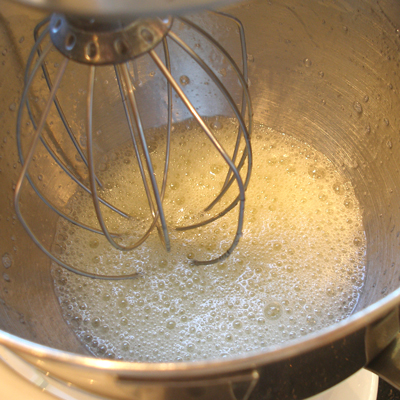
3. Increase the mixer speed to medium-high and beat until whites form soft peaks, taking about 2 to 3 minutes.
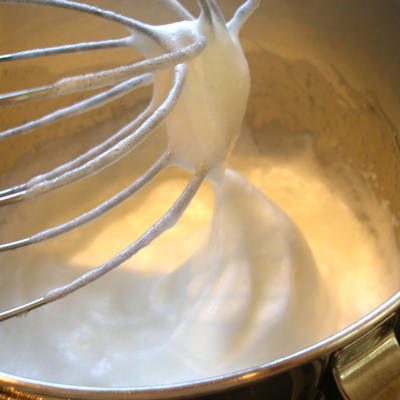
4. Slowly add the sugar in a steady stream at the side while beating, and then the vinegar and vanilla. Increase the mixer speed to high and beat until stiff and glossy. Them, STOP!
SARAH SAYS: If egg whites are beaten to dry and dull, they are overbeaten — Watch carefully, because egg whites can go from stiff to dry and overbeaten in as little as 30 seconds.



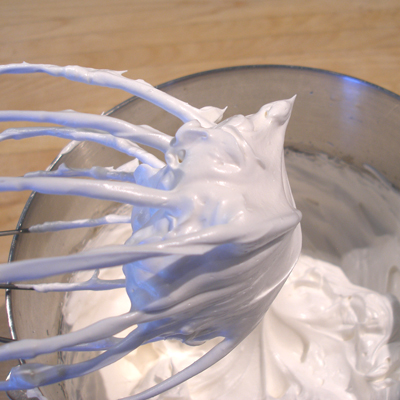
5. Sift the cornstarch and salt over the whites with a small fine mesh strainer. Gently fold in with a large rubber spatula.
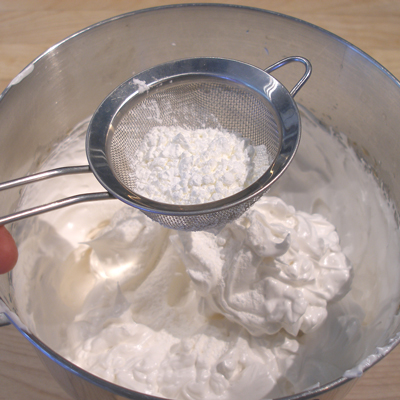

Form the Pavlova meringue shells: two options
Option 1 – With a large spoon:
1. Immediately, heap half of the meringue onto one circle on the parchment paper at a time, GENTLY swirling it out with a large rubber spatula or with the back of a large soup spoon to fill out the 8-inch circle.
Make sure you form higher sides around the edge, leaving a wide indentation in the center, taking care not to make it too thin. The meringue will puff during baking.

Option 2 – With a piping bag fitted with tips:
SARAH SAYS: Instead of making the pavlova shape with a spoon, you can pipe the meringue onto the traced circle, making designs, as we do below:
1. To pipe the meringue, place the meringue in a piping bag, fitted with a large open tip.
2. Pipe small dots of the meringue on the corners of each baking sheet and press the parchment with the circle drawn on it, into place.

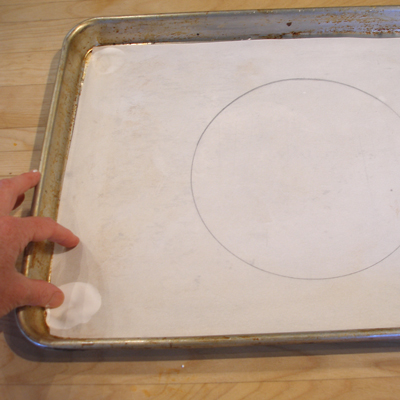
3. Pipe the meringue, in a tight spiral, starting from the outside of the circle.
NOTE: Start piping on the inside of the drawn circle.
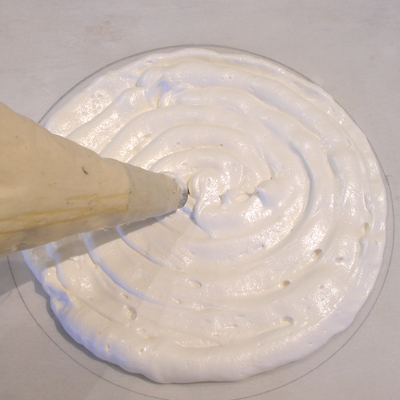
4. Smooth the ridges with a small offset spatula.

5. If you have any meringue left after piping the circle, squeeze it back into the bowl of meringue.
6. Fill another piping bag, fitted with a large open star tip, with all the remaining meringue.
Pipe rosettes of meringue all around the perimeter of the meringue base; do not fill in the center.

7. Using the same tip, then pipe smaller stars of meringue between each rosette.



STEP II: BAKE THE PAVLOVA MERINGUE SHELLS
1. Immediately put the Pavlova meringue shell in middle of oven and reduce heat to 200 degrees F to bake for 1 hour.
2. Then, in the last 1/2 hour, turn the oven down to 175 degrees F.
Bake until the meringue is set but somewhat soft when pressed lightly with a fingertip. You don't want it to get too dark in color.
SARAH SAYS: You do not want to bake the meringue shell until it dries out; a pavlova should be somewhat crisp on the outside and chewy on the inside.
3. Turn the oven off, crack the oven door, and let the baked Pavlova meringue shell cool in the oven for 1/2 hour.
4. Then remove the baking sheet from the oven and let it come to room temperature.
5. DO NOT attempt to remove the parchment paper until the meringue shell is completely cool!

STEP III: MAKE THE WHIPPED CREAM. ASSEMBLE THE PAVLOVA CAKE AND SERVE.
Make the whipped cream: Whip cream to soft peaks.
1. In a mixing bowl, add the cream, sugar and vanilla extract.
2. Using a hand-held electric or stand mixer, beat on low-speed until small bubbles form, about 30 seconds, and then increase the speed to medium and then to high.
Move the beaters up and down and around the side of the bowl while whipping if using a hand-held mixer. With a rubber spatula, scrape down the side of the bowl often.
3. Stop whipping when the cream has doubled in volume, is smooth, thick and billowy when the beaters are raised.
4. Set aside or refrigerate until needed.
Assemble:
1. Place one baked and cooled Pavlova meringue shell on a flat platter,
2. Then spoon on passion-fruit pulp.
3. Pile the whipped cream on top.
4. Arrange cut fruit over the whipped cream.
SERVE
Slice pavlova into wedges to serve.
STORAGE
The meringue shells can be made ahead and stored in airtight container in dry, cool place up to 2 weeks or frozen in airtight container up to 3 months.
The filled pavlova with whipped cream and/or fresh fruit, must remain refrigerated where it will keep for a few days; it will not freeze.
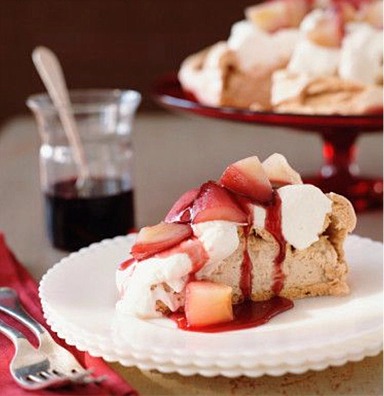
stock photo
Fruit Topping Suggestions
Nectarines, blueberries, and raspberries
Peaches, plums, golden raspberries, blueberries
Mangoes, bananas, oranges, pink grapefruit
Apples, pears, grapes, dried cranberries


